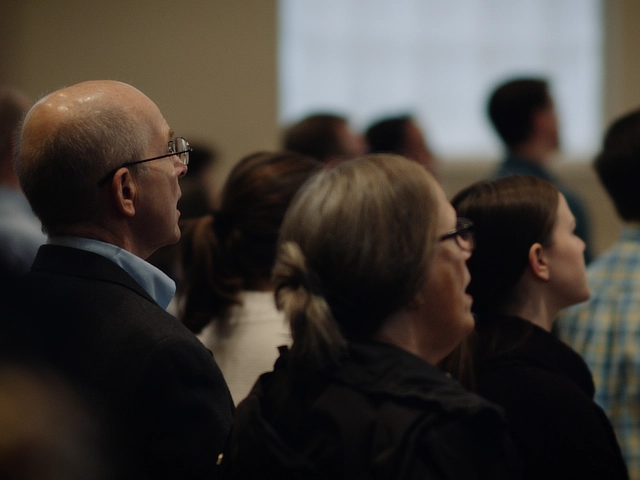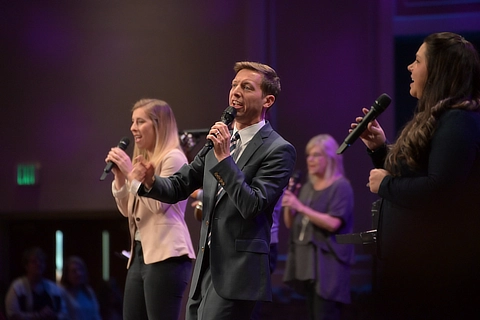
Healthy congregational worship is incarnational. That is, it comes to life—in flesh and blood—as the church gathers to lift songs and prayers in worship to God. The church is both global and local, and it’s important for worship leaders to give time and attention to understanding their church unique as a local church.
Like a person, the local church is an organism, and it carries its own unique personality and character. The personality and character of a congregation reflect the people within it, who, in turn, reflect the context and culture in which they live. This shared culture is often determined by various factors including, but not limited to, location, language, socio-economic status, education, etc. In other words, there is a unique context and community within which congregational worship comes to life, and this will be the focus of today’s post. Armed with this knowledge, a worship leader can increase his/her leadership effectiveness and sidestep some common pitfalls.
To say it simply, a congregation is a community while also functioning as a microcosm of the larger body of Christ. Yet, this congregation also exists within a larger community such as a suburb, town, city, county, etc. Then, within a specific suburb or town, one may find various contexts that distinguish the personality of one church from another. One of the most defining contextual markers is a church’s denomination. Healthy congregational worship is intentional to embrace and affirm the beliefs and priorities of the church’s denomination and leadership.
Of course, congregational worship existed long before the plethora of denominations that we currently see, but over the long and storied history of denominations, certain values (especially in worship) have become defining traits that distinguish denominations. Knowing these values is essential in leading your congregation well and avoiding potential conflict. Outlining the possible denominational differences in worship is outside the scope of this post. Suffice it to say, it would be worth a conversation with your leadership (and some personal study) to discover the guidelines, values, and practices that have marked your church’s denomination.
Apart from denominational guidance, many churches enjoy a level of autonomy that gives them freedom to order worship according to pastoral leadership and congregational preference. Considering this, it is still essential to have a solid grasp of the church’s vision, mission statement, and any theological priorities or doctrinal statements. These elements often serve as both the foundation and infrastructure of churches, and congregational worship that is contextual will steady itself upon that foundation and within that framework.
The incarnational nature of the church also requires worship leaders to fully embrace the understanding that “church” is not something we do but rather it is something we are. After all, a church is not a building, it is people; and healthy congregational worship engages and reflects its membership. How well do you know your membership? Does your administrative office keep statistics on the demographics of church membership? What do you know about where most people work or the most common type of work? How old are they? What is their ethnicity? Do you personally know and interact with church families and learn their unique story? What are common needs/wants/fears? Common recreational activities? Unique challenges of life? What is their involvement and history at the church? What are the various clusters of families who are close friends? These kinds of questions can help you understand the unique make up of your congregation. One caution is that often leaders plan and prepare worship for the congregation they wish they had rather than the one they actually have. Make sure to look out during any given Sunday and see who is under your leadership. Look into their faces and know that behind every set of eyes is a soul valued by God. Here are a few examples of the types of information about your congregation that can be helpful:
- Certain topics might be more sensitive in one church than another because of something that happened in the past with a family/families.
- A large part of the congregation might have the same employer or type of employment that places certain expectations on its employees or has unique work hours (medical community, offshore work, etc.)
- Sports may be highly valued, and families are gone more frequently to play tournaments or travel ball.
- An affluent community may spend more time traveling to second homes or on multiple vacations.
- A large portion of the congregation may value homeschooling over public education.
- Certain members may be involved in city government or school leadership and are making decisions that could affect a large portion of the church’s membership.
The more of this information you have, the more you can plan and lead worship that ministers to your people.
Finally, all communities have neighbors. That’s one of the defining characteristics of a community. Is your church known for being a good neighbor? Are your services hospitable to guests and those who are not familiar with your context? What processes are in place to help guests move from the fringes to the interior of your church community? Worship can orient or alienate people, so what can you do in worship to help orient people to the nature, purpose, and activities of the worship gathering? Here a just a few tangible elements that often distinguish a church’s context/community and also orient or alienate guests. They are placed here on a spectrum to help you determine where your church might fall within that spectrum.
Attire for congregation:
Formal............................................................................................... Informal
Attire for pastoral leadership:
Formal............................................................................................... Informal
Service leadership language:
Scripted............................................................................................. Improvised
Service approach:
High Church...................................................................................... Low Church
Friendliness:
Icy Cold............................................................................................. Fireside Warmth
Time-consciousness:
Strict.................................................................................................. Loose
People are often alienated by assumptions that those in leadership make about people’s understanding of worship and even the purpose of the church. Take time to intentionally but briefly share why we gather, stand, sing, pray, read scripture, listen to a sermon, give tithes/offerings, baptize, take communion, etc. In doing so, you are inviting other to join in not only your unique church community but the community of believers for all time.
This is part seven of an eight-part series on Vital Signs for Healthy Corporate Worship. Additional articles include:
- Worship Check-up: Vital Signs for Healthy Congregational Worship
- Healthy Congregational Worship—Is Trinitarian in Nature
- Healthy Congregational Worship—Encourages Vibrant Congregational Singing
- Healthy Congregational Worship—Is Planned and Prepared
- Healthy Congregational Worship—Activates Vertical and Horizontal Relationships
- Healthy Congregational Worship—Is Timely and Timeless
 Jonathan P. Rodgers is Area Coordinator of Music and Worship, Director of the Samford Worship Collective, and Faculty Fellow for The Center for Worship and the Arts at Samford University. He has been directing choirs in schools and the church for over fifteen years. As a clinician and presenter, Rodgers has been a guest conductor for honor choirs throughout the Southeast. Currently, he is serving as Minister of Music and Worship at Liberty Park Baptist in Birmingham, Alabama. Prior to this position, Rodgers was Minister of Music and Worship Arts at Hunter Street Baptist Church, and prior to that, Assistant Professor of Choral Music at Lee University in Cleveland, Tennessee. In addition to his conducting and scholarly activities, Jonathan is an active pianist, church musician, and composer. Jonathan has been married to his wife Alicia for seventeen years, and they have four children: Savannah, Leighton, Brooks, and Gabe.
Jonathan P. Rodgers is Area Coordinator of Music and Worship, Director of the Samford Worship Collective, and Faculty Fellow for The Center for Worship and the Arts at Samford University. He has been directing choirs in schools and the church for over fifteen years. As a clinician and presenter, Rodgers has been a guest conductor for honor choirs throughout the Southeast. Currently, he is serving as Minister of Music and Worship at Liberty Park Baptist in Birmingham, Alabama. Prior to this position, Rodgers was Minister of Music and Worship Arts at Hunter Street Baptist Church, and prior to that, Assistant Professor of Choral Music at Lee University in Cleveland, Tennessee. In addition to his conducting and scholarly activities, Jonathan is an active pianist, church musician, and composer. Jonathan has been married to his wife Alicia for seventeen years, and they have four children: Savannah, Leighton, Brooks, and Gabe.
